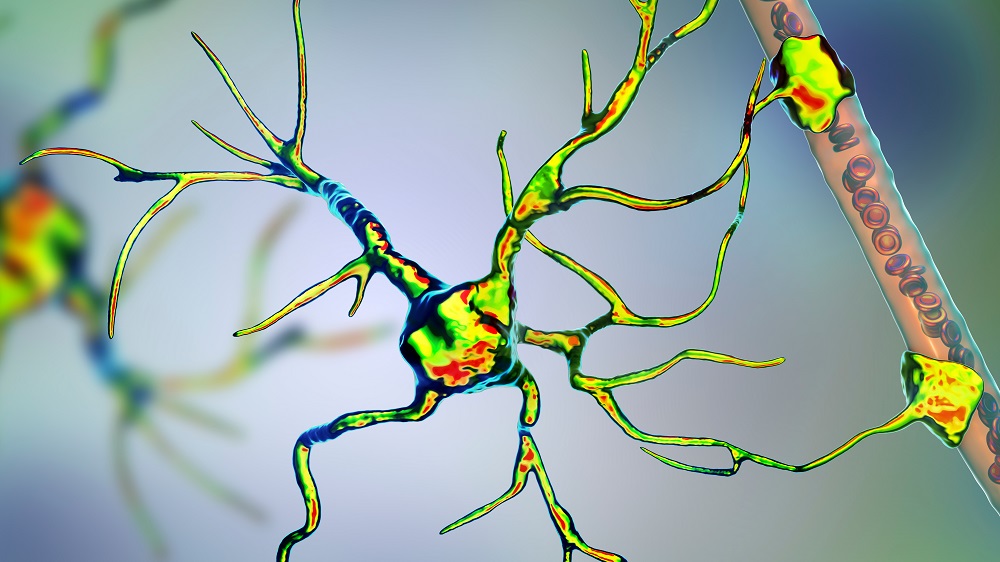An article in GeroScience describes a previously unexplored relationship between FABP7, an inflammatory molecule that binds to fatty acids, and Alzheimer’s disease.
Not just a transporter
Originally, as the authors explain, fatty acid binding proteins (FABPs) were considered to be simple biological chaperones that did not perform biological functions. Further research found that they play an active role in metabolism and inflammation [1]. These researchers have done previous work that found that one member of this family, FABP7 causes astrocytes to be toxic to neurons in the context of amyotrophic lateral sclerosis (ALS) [2].
On the other hand, previous work has found that inflammation is a double-edged sword in Alzheimer’s. While astrocytes degrade the amyloid beta protein characteristic of Alzheimer’s disease [3], the inflammation they produce was found to be toxic in Alzheimer’s as well [4].
Other research has found that the issue is complicated, as the well-known anti-Alzheimer’s allele APOE4 is associated with downregulation of FABP7 in neurons but not astrocytes [5]. These researchers, therefore, decided to further explore the role of FABP7 in Alzheimer’s disease.
FABP7 is increased in Alzheimer’s mice
Just like the mouse model they used of ALS [2], mice that have been genetically engineered to experience Alzheimer’s have twice as much FABP7 in the cortex as wild-type mice. Most, but not all, astrocytes showing the specific GFAP+ marker were found to express dozens of times more FABP7 than in wild-type controls. This increase was directly linked to proximity to amyloid beta plaques, as nearby cells produced about one and a half times more FABP7 than cells that were slightly farther away.
This increase, however, did not cause apparent harm to the astrocytes in question, with astrocyte survival being very similar between Alzheimer’s mice and controls. However, RNA analysis found that more FABP7 was associated with increases in inflammation, including cytokines
FABP7 and inflammation in human cells
The researchers then turned to astrocytes created from human stem cells. They created three populations: a control group that only expressed a reporter protein, a group expressing normal FABP7, and another group expressing a mutant form of FABP7 that lacks the ligand binding necessary for proper function.
Only the second group affected the well-known NF-κB signaling pathway. The overexpression of NF-κB was linked to multiple inflammatory compounds, including interleukins and the CXCL10 protein, along with nitric oxide synthesis. These results were confirmed in cell cultures taken from mice, demonstrating a similarity in pathology and a potential explanation for inflammation in Alzheimer’s disease.
However, while this sheds light on a previously unexplored relationship and adds yet another puzzle piece to Alzheimer’s biology, it is a downstream explanation of the likely effects of amyloid beta on inflammation rather than the other way around. Furthermore, no treatment directly targeting FABP7 has been found. More work will need to be done in order to determine if reducing FABP7 levels is effective in modulating harmful neuroinflammation and slowing the decline associated with Alzheimer’s and other diseases.
Literature
[1] Thumser, A. E., Moore, J. B., & Plant, N. J. (2014). Fatty acid binding proteins: tissue-specific functions in health and disease. Current Opinion in Clinical Nutrition & Metabolic Care, 17(2), 124-129.
[2] Killoy, K. M., Harlan, B. A., Pehar, M., & Vargas, M. R. (2020). FABP7 upregulation induces a neurotoxic phenotype in astrocytes. Glia, 68(12), 2693-2704.
[3] Wyss-Coray, T., Loike, J. D., Brionne, T. C., Lu, E., Anankov, R., Yan, F., … & Husemann, J. (2003). Adult mouse astrocytes degrade amyloid-ß in vitro and in situ. Nature medicine, 9(4), 453-457.
[4] Van Eldik, L. J., Carrillo, M. C., Cole, P. E., Feuerbach, D., Greenberg, B. D., Hendrix, J. A., … & Bales, K. (2016). The roles of inflammation and immune mechanisms in Alzheimer’s disease. Alzheimer’s & Dementia: Translational Research & Clinical Interventions, 2(2), 99-109.
[5] Asaro, A., Sinha, R., Bakun, M., Kalnytska, O., Carlo-Spiewok, A. S., Rubel, T., … & Willnow, T. E. (2021). ApoE4 disrupts interaction of sortilin with fatty acid-binding protein 7 essential to promote lipid signaling. Journal of cell science, 134(20), jcs258894.







